When he gets his bat on the ball, few hitters are as dangerous as Jorge Soler. The prevailing issue, of course, has been that Soler has had a significant issue actually making contact. There are other issues too. Early on, he put the ball on the ground too often, and he popped up at a clip that was well above-average. Until recently, he’d really only been a strong hitter against fastballs. Together, these issues make for a lot of problems, which often leads to a pretty dreary outlook for players. Well by golly, Soler appears to have circumvented these holes in his game to produce numbers akin to those of the best power hitters across the league.
Here’s Soler, demolishing a pitch off of Edwin Jackson:
https://gfycat.com/halfcolossalindianabat
That was his hardest-hit ball on the year, at 115.7 mph.
And then we have Soler demolishing a different pitch, this time off of Jake Odorizzi:
https://gfycat.com/vaindigitalcutworm
This wasn’t as much of a meatball as the last pitch, but he deposited it into the seats nonetheless, with a 114.4 mph exit velocity. These two pitches have a few things in common. Most obviously, they’re both pitches that he gets out in front of, and as a result, they’re both hit very hard to his pull-side. The other thing, though, is that both of these pitches are first-pitch offerings, and of the fastball variety. That’s not an accident.

Data Visualization by Nick Kollauf (@Kollauf on Twitter)
Soler ranks in the top 10 in average exit velocity on fastballs, the best in baseball on xwOBAcon on fastballs, and the best against xwOBA against fastballs. He was already a great fastball hitter, but depending on how you look at it, no one was a better fastball hitter than Soler in 2019. The thing is, he’s not so shabby against non-fastballs now, either.

Data Visualization by Nick Kollauf (@Kollauf on Twitter)
This is a pretty significant development in his game. It’s not that he was bad against slower stuff before—he was basically league-average. But now, he’s taken a huge step forward. Already a fastball destroyer, he’s folded in the ability to hit slower pitches too. He would have been fine as he was, making his money off of demolishing fastballs, but now he’s one of the best power hitters in baseball. Now, he did get better against fastballs, but you’re not going to believe how he made the bulk of his improvements against non-fastballs. (Or perhaps you will!)
Here’s Soler’s, xwOBA against non-fastballs in 2019 versus pre-2019:
| Pre-2019 | 2019 | |
|---|---|---|
| Heart | 0.283 | 0.419 |
| Shadow | 0.229 | 0.250 |
| Chase | 0.258 | 0.211 |
Again, maybe this isn’t that surprising. Good hitters capitalize on bad pitches, and you can bet that a good chunk of non-fastballs in the heart of the plate are mistake pitches. He could probably stand to stay away from the more alluring pitches off the plate, but for now, this is huge. Put simply, he wasn’t punishing mistakes, and now he is. There are improvements to be had, but we’re really starting to split hairs here—Soler finished in the top five percent in exit velocity, hard hit percentage, xwOBA, expected slugging percentage, and barrel percentage. It’s hard to ask for much more.
I hinted at it earlier, but the interesting thing is that, in many ways, Soler hasn’t improved. He’s walking and striking out about the same amount, and his plate discipline numbers are, for the most part, only marginally improved. The main difference here is that when Soler gets his bat on the ball, he’s hitting it in the air more, and a lot harder than he ever has. It appears that Soler has made a mechanical adjustment.
Here’s Soler taking a cut at the top of the zone in 2018:
https://gfycat.com/pleasingdishonestbrant
And here’s a swing on a similar pitch, this time in 2019:
https://gfycat.com/mintyhealthyilsamochadegu
Hitting the ball hard has never been the issue. For Soler, it’s been getting the ball off the ground, and hitting the ball more consistently. Let’s take a look at Soler’s swings more closely. The first thing to take note of is that Soler is setting up differently.
Here’s Soler’s 2018 stance (top) against his 2019 stance (bottom):
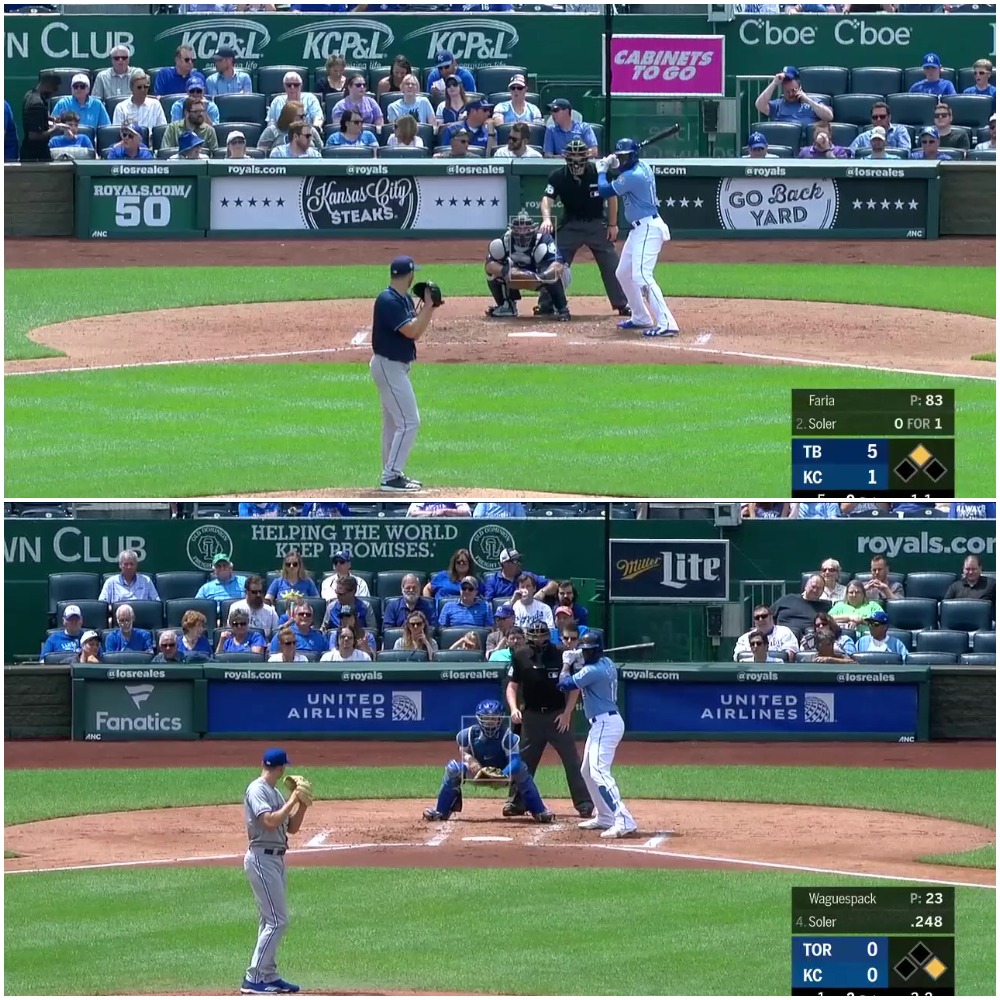
It’s not super drastic, but he’s setting up straighter, with his stance slightly more closed. Perhaps to compensate for the straighter stance, Soler has adopted a bigger leg kick too.
Here’s Soler’s leg kick peak in 2018:

And then here’s where his leg kick peaks in 2019:
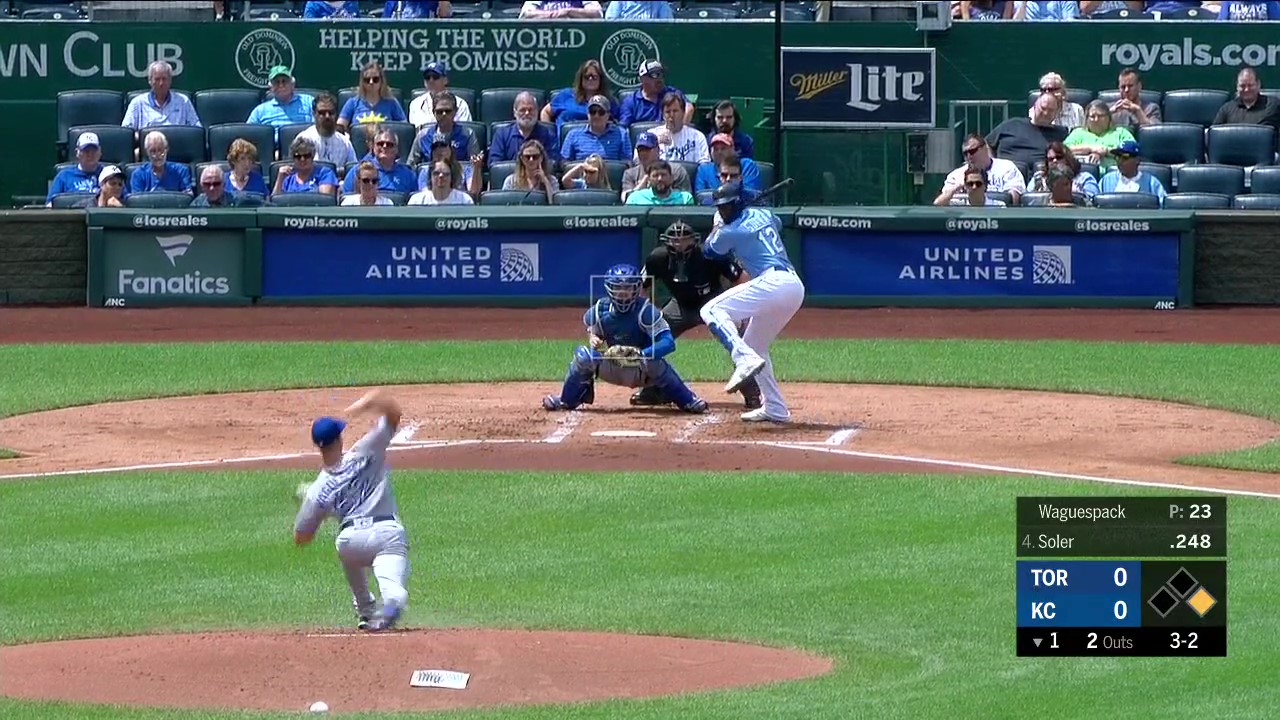
It’s higher! Much higher. This change has had a few favorable side effects. It allows Soler to tap into more strength from his lower half, but it’s also served as a nice timing mechanism for him. This year, once he plants his front foot, he’s ready to spring his hands towards the ball, all in a much cleaner, more fluid motion. His hands seem a little quieter too, but as far as I can tell, the leg kick has been the catalyst of Soler’s growth in 2019.
Here are the two swings side-by-side, synced at the point of contact. 2019 on the left, and 2018 on the right:
https://gfycat.com/adoredgreatarrowana
Now, I’m pulling just one swing from each year above, but it seems that more than ever, Soler has been able to do something with pitches he previously wasn’t.
Soler’s home runs on fastballs in 2018, by location:
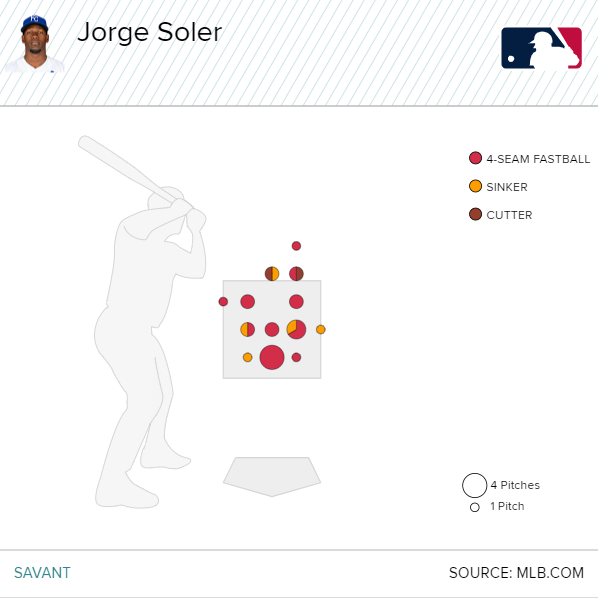
Soler’s home runs on fastballs in 2019, again, by location:
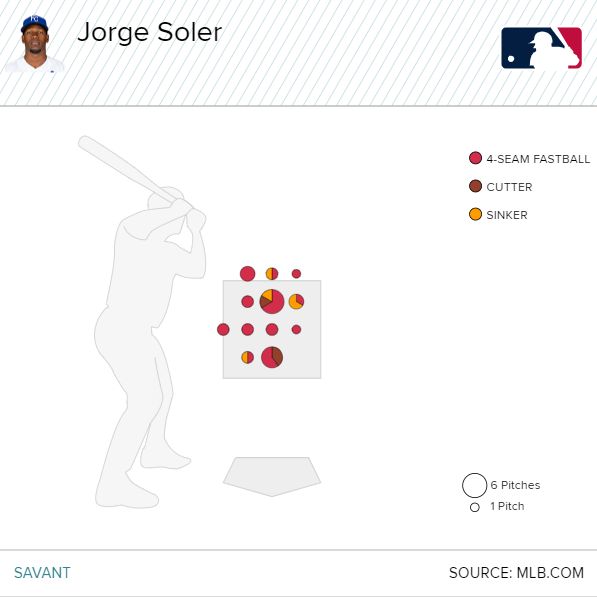
Overall, the pitches have moved in. While he used to pretty evenly cover the plate, he’s made the top of the zone and the inside of the plate a nightmare for pitchers. While he graded out as an above-average hitter before when hitting to his pull-side (.425 xwOBA), he’s become a premier hitter in the way of pulling with ball, with a .549 xwOBA that ranks him in the 95th percentile alongside the likes of Cody Bellinger and Miguel Sano.
And then there’s this: By production, Soler reminds me an awful lot of Giancarlo Stanton, and they have some mechanical similarities as well. Now, Soler’s got a leg kick, and their pre-pitch setup isn’t at all similar, but once he gets his front foot down, the two look comparable. Years ago, Stanton made a change to his pre-pitch setup, in which he drastically closed his stance. It seems like Soler’s leg kick may have helped him stop pulling off of the ball as well.
Consider this side-by-side comparison of Soler (left) and Stanton (right):
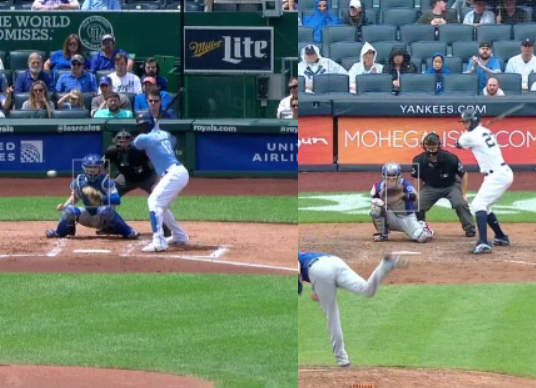
Soler’s finish isn’t dissimilar at all from Stanton’s, in my eyes. Perhaps we shouldn’t be surprised that, since Stanton tweaked his stance in 2017 and Soler tweaked his in 2019, the two aren’t all that different in the way of results.
Here’s how their numbers stack up since their respective adjustments:
| BB% | K% | ISO | FB% | Contact% | Pull% | |
|---|---|---|---|---|---|---|
| Soler | 10.8 | 26.2 | 0.304 | 41.2 | 69.9 | 46.7 |
| Stanton | 11.3 | 27.0 | 0.292 | 37.7 | 69.0 | 42.0 |
As you can see, there’s a precedent here for Soler, and, on the whole, it looks a lot like Stanton. There are few key differences: Stanton hits the ball on the ground quite a bit, and Soler sells out to his pull-side more. But there are several similarities in terms of plate discipline and how they impact the ball. With that, I think it’s safe to say that Soler can feasibly post elite power numbers again in 2020.
There aren’t many reasons to not buy in here. Soler has changed for the better, and we can parallel those improvements to the changes he’s made. There’s always the chance that these changes don’t stick—Soler could fall back into his old ways, returning to his old mechanics. But for now, Soler has adjusted and optimized for his particular skill set. We’ll see how pitchers adjust to him when baseball returns, but Soler has established himself as perhaps the league’s best fastball hitter, with the newfound ability to hit slower stuff too.
Jorge Soler by Cody Glenn & Gerry Angus/Icon Sportswire | Adapted by Zach Ennis (@zachennis on Twitter and Instagram)


I picked Soler off of waivers last season in April and I am a believer. I picked him up this year as well, lower than I thought. Being on the Royals helps him stay under the radar.
This was lit. Really nice job by Ajeto. I have nothing of value to add other than jut saying I enjoyed reading this.